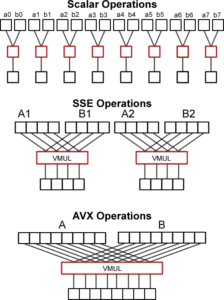Acceleration of PIAS
Some tasks of PIAS can be quite computation-intensive, such as the computation of intact stability (in particular if enhanced features are active, such as the shift of liquid method, and/or stability around the weakest axis) and damage stability, but also the generation of curved surfaces in Fairway. Time was that each new computer generation was faster than its predecessor, mainly thanks to processor clock frequency increase, but that has come to a halt a decade ago. Nowadays, CPU manufacturers try to stimulate performance gains by means of parallelization, so that multiple tasks can be executed simultaneously. In the recent weeks, at SARC, we have been working to optimize (LOCO-)PIAS with these technologies, with the goal to cramp out all possible performance out of modern hardware.
This resulted for some PIAS applications in a speed increase of a factor 3 to 8, depending on the task and the hardware.
In a separate document Acceleration of PIAS by hardware support the background and results are described into some detail.

Keep up to date with the latest news, follow us on Facebook and LinkedIn.

